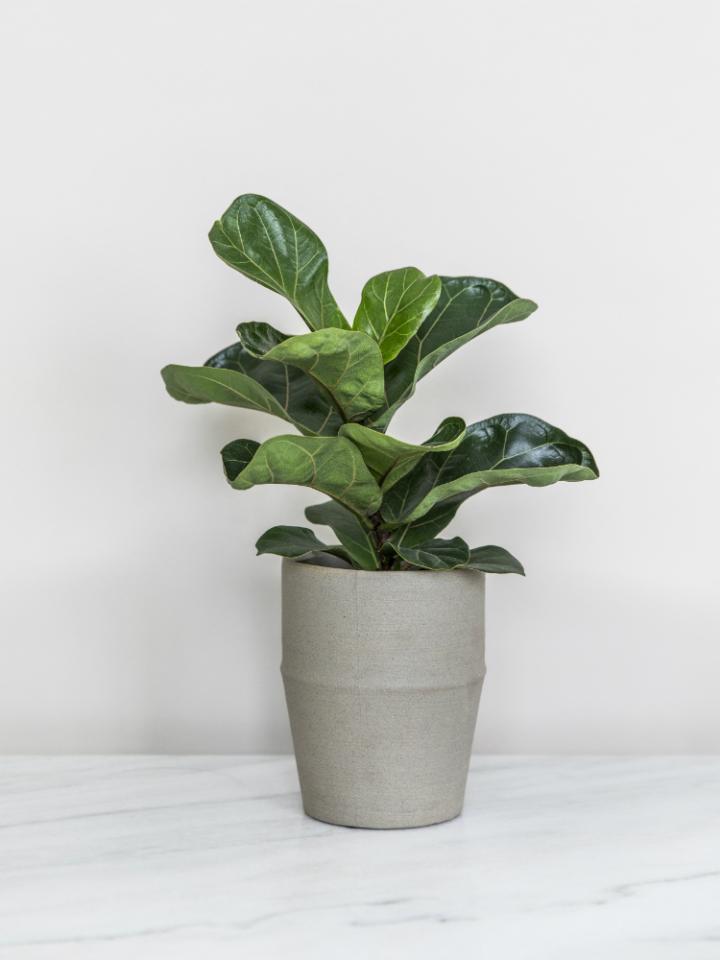Ficus Lyrata: characteristics and classification
Ficus Lyrata, also known as the Fiddle Leaf Fig, is an impressive houseplant. You can recognise the plant by its large, shiny and leathery leaves in the shape of a violin. The leaves can grow up to about 50 centimetres long, making them a main feature of this green beauty. The dark green leaves have prominent, light veins, which are sunken into the violin-shaped leaf. Figs can grow on the plant, but they highly unlikely to sprout in your living room.
Ficus Lyrata belongs to the Moraceae, or Mulberry, family, which also includes plants such as Fig Tree and Mulberry. In nature, this cousin of the fig tree can grow so enthusiastically that it can suffocate the tree it grows against, growing a massive 12-15 metres tall. In your living room, it won't grow that large as long as you prune it regularly.
Ficus Lyrata species
The Ficus family is large, with around 750 known species. Ficus Lyrata is a popular houseplant that has several varieties, each with its own unique characteristics and features. These are the best known Ficus Lyrata varieties:
- Ficus Lyrata ‘Standard’: this is the regular Ficus Lyrata that is most familiar. It can be recognised by its thick, green and shiny leaves with a violin shape. This species has an upright growth habit and the leaves can grow up to 50 centimetres long.
- Ficus Lyrata ‘Compacta’: this is the compact version of the common Ficus Lyrata. The leaves of this Ficus are smaller and the plant has a fuller, bushier appearance. This species grows less tall and is thus more suitable for smaller spaces.
- Ficus Lyrata ‘Bambino’: this is the miniature version of this popular plant. The violin-shaped leaves of this species are much smaller than those of regular Ficus Lyrata. The leaves of this species grow close to the stem, branch out more and also grow more slowly than those of the ordinary Ficus Lyrata. This makes ‘Bambino’ suitable for smaller spaces or for placing on a table.
- Ficus Lyrata ‘Variegata’: this rarer species has striking leaves with green and cream/white marble-like markings. This makes the violet-shaped leaves look extra special.
Ficus lyrata tree
Some varieties of Ficus Lyrata, such as the ‘regular’ Ficus Lyrata (Ficus Lyrata ‘Standard’), have been bred specifically to develop a trunk. These varieties take on a tree-like appearance from their base. Other species grow in bushy form with multiple branches and a bushy appearance, but can develop into a more tree-like appearance if the plant is given the right care and space - in other words, you will have to be patient, prune the plant (remove lower branches to form a single stem) and support it carefully (place a stick or other support against the plant so that the stem grows straight upwards).

Caretaking and location of Fiddle Leaf Fig plant
If you've just brought a brand-new Fiddle Leaf Fig plant home, you'll want to make sure it's happy. Check out some basic rules for houseplant care here and see our tips below on specific care and location advice for Ficus Lyrata:
- Give Ficus Lyrata small amounts of water so that its soil remains evenly slightly moist. Don't water too much at once. In winter, the plant needs less water than during the summer.
- Water your Fiddle Leaf Fig when the top layer of the soil has dried out a little.
- Ficus thrives best in high humidity. You can spray the plant with a plant spray to achieve this.
- Ficus Lyrata thrives best in a light and warm place, but not in bright sunlight.
- Avoid cold temperatures and draughts. Ensure a temperature of at least 15°C.
- Preferably, you should give Ficus Lyrata a heavy pot. The plant can grow quite tall and become very heavy at the top, so a sturdy pot gives the plant stability.
- Are no new leaves appearing, or are the leaves getting smaller? Then your plant is getting too much shade.
- It;s not necessary to feed Ficus Lyrata, but you can give it universal plant food during the growing season (spring and summer) to stimulate healthy growth.
- Turn the Ficus Lyrata regularly. This ensures that the plant grows symmetrically and straight. Leaves that catch a lot of light will grow larger than those that catch less light.
Brown spots on your Fiddle Leaf Fig?
Is your Ficus Lyrata developing brown spots? You can tell from the leaves whether you give the plant too much or too little water. Too little water will turn them brown; the leaves may get brown spots and/or fall off. If this is the case, water your plant more often and spray it with a plant sprayer. Is only one leaf falling off? That could also be a sign that the leaf was old. If it's getting too much water, the Ficus leaves will droop and turn yellow.
when should you prune Ficus Lyrata?
Pruning or trimming Ficus Lyrata isn't strictly necessary, but if you think your plant is growing too big or tall, or if you want to give it a fuller look, you can choose to prune it. Before you get started, here are a couple of tips:
- Preferably, you should prune Ficus Lyrata in spring, as this is when the plant is in an active growth phase, so it recovers the fastest.
- When pruning, be careful not to come into contact with the white sap as it' toxic and can cause skin irritation. We recommend putting on gloves.
How to prune Fiddle Leaf Fig plant
- Take a good look at the shape of your Ficus Lyrata from all sides. Which branches are growing in the wrong direction and should be shortened, and which branches are getting too tall?
- Cut off the desired branches with sharp, clean pruning shears. Cut the branches to just above a leaf.
- Is the plant getting too tall? Then cut the top off just above a leaf.
- When you prune Ficus Lyrata, milky white sap may come out of the pruning wound. This sap can cause skin irritation, so avoid skin and eye contact and wear gloves when pruning. If you do come into contact with the sap, rinse it off your skin immediately.
- Does the pruning wound keep ‘bleeding’ with the milky white sap? Then you may want to cover the wound with candle wax to protect it.

How and when do you take Fiddle Leaf Fig cuttings?
Planning to take cuttings and propagate your Ficus Lyrata? If so, check out this article on cuttings and then take a look at our step-by-step plan for propagating Ficus Lyrata below.
There are several ways to propagate a houseplant, but Ficus Lyrata lends itself best to so-called head cuttings. This means that you use the upper leaves of the plant to make a new cutting. You should plant your Ficus Lyrata during the growing season (spring or summer), as that is when the cutting grows and roots most easily.
Ficus Lyrata cuttings: a step-by-step plan
- Cut off about 10 centimetres from the end of a branch with a maximum of 2 leaves on it (a larger cutting with more leaves evaporates more water, which reduces the chance of achieving cutting success). Cut off the cutting just above a leaf on the mother plant.
- Place the cutting directly into lukewarm water and put it in a light and warm place (around 20°C) and wait for it to root. This may take several weeks! Be careful not to put the cutting in direct sunlight, as this can burn it.
- Has the cutting grown sufficiently large roots (about 5 centimetres)? Then you can plant the cutting into a pot with potting soil. Keep the soil slightly moist. Too-dry soil makes the cutting dry out, and too-wet soil makes it root less well.
- Repot the cutting into a larger pot when the plant is big enough.
Ficus lyrata and Fiddle Leaf Fig symbolism
Ficus Lyrata has several symbolic meanings, mostly associated with strength, happiness and abundance. In nature, Ficus Lyrata grows as an imposing tree, symbolising endurance and strength. In many Asian cultures, Ficus Lyrata is seen as a plant that attracts health and prosperity. The plant owes this to its large, shiny leaves. Like many other large houseplants, Ficus Lyrata is also associated with prosperity and positive energy.
Is Ficus Lyrata/Fiddle Leaf Fig poisonous?
Yes, Ficus Lyrata is toxic to humans and animals, including dogs and cats. Ingestion and contact with the plant's milky sap can cause skin irritation. Ingestion of leaves can also cause irritation, such as rashes and upset stomachs. Contact a veterinary or doctor following ingestion, and learn more about toxic and safe plants here.
Fiddle Leaf Fig plant origins
Ficus lyrata originates from the tropical rainforests of West and Central Africa. It thrives there in the warm, humid environments of countries such as Liberia, Gabon and Cameroon. Ficus Lyrata grows there in the wild as a large tree, which can grow up to 15 metres tall.
Ficus Lyrata was probably first introduced to Europe and other continents in the 18th century, through trade routes between Africa and Europe when plants were collected by explorers and botanists. During the Victorian era (the 19th century), interest in tropical plants such as Ficus Lyrata grew. Botanical gardens played a key role in its rise in popularity.
In the 20th century, especially from 1970 onwards, Ficus Lyrata became increasingly popular as a houseplant. Its large, striking leaves make the imposing Ficus a popular plant in many living rooms, offices and public spaces worldwide.











